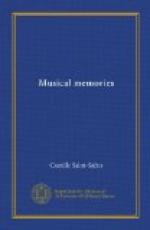Berlioz spoke scornfully of Mozart’s Tuba Mirum with its single trombone. “One trombone,” he exclaimed, “when a hundred would be none too many!” Berlioz wanted to make us really hear the trumpets of the archangels. Mozart with the seven notes of his one trombone suggested the same idea and the suggestion is sufficient.
We must not forget, however, that here we are in the midst of a world of romanticism, in a world of color and picturesqueness, which could not content itself with so little. And we must remember this fact, if we would not be irritated by the oddities of L’Hostias, with its deep trombone notes which seem to come from the very depths of Hell. There is no use in trying to find out what these notes mean. Berlioz told us himself that he discovered these notes at a time when they were almost unknown and he wanted to use them. The contrast between these terrifying notes and the wailing of the flutes is especially curious. We find nothing analogous to this anywhere else.
The delightful Purgatoire, where the author sees a chorus of souls in Purgatory, is much better. His Purgatory has no punishments nor any griefs save the awaiting, the long and painful awaiting, of eternal happiness. There is a processional in which the fugue and melody alternate in the most felicitous manner. There are sighs and plaints, all haunting in their extreme expressiveness, a great variety beneath an appearance of monotony, and from time to time two wailing notes. These notes are always the same, as the chorus gives them as a plaint, and they are both affecting and artistic. At the end comes a dim ray of light and hope. This is the only one in the work save the Amen at the end, for Faith and Hope should not be looked for here. The supplications sound like prayers which do not expect to be answered. No one would dare to describe this work as profane, but whether it is religious or not is a question. As Boschot has said, what it expresses above all is terror in the presence of annihilation.
When the Requiem was played at the Trocadero, the audience was greatly impressed and filed out slowly. They did not say, “What a masterpiece!” but “What an orchestra leader!” Nowadays people go to see a conductor direct the orchestra just as they go to hear a tenor, and they arrogate to themselves the right to judge the conductors as they do the tenors. But what a fine sport it is! The qualities of an orchestra conductor which the public appreciates are his elegance, his gestures, his precision, and the expressiveness of his mimicry, all of which are more often directed at the audience than at the orchestra. But all these things are of secondary consideration. What makes up an orchestra conductor’s worth are the excellence of execution he obtains from the musicians and the perfect interpretation of the author’s meaning—which the audience does not understand. If such an important detail as the author’s meaning is obscured and slighted, if a work is disfigured by absurd movements and by an expression which is entirely different from what the author wanted, the public may be dazzled and an execrable conductor, provided his poses are good, may fascinate his audience and be praised to the skies.




